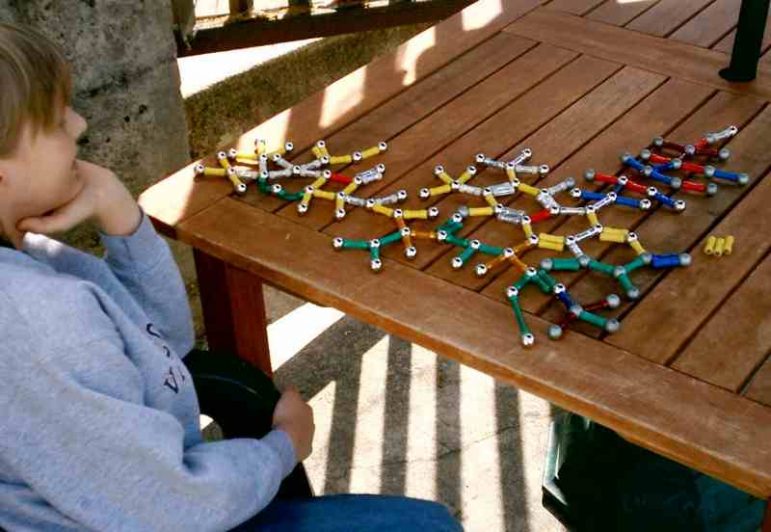Picture if you will, a highly intelligent, glib, absent-minded professor. His mind is keen but he lacks social skills. He has obsessive tendencies and seems to like live in his own world. If you’ve ever known someone like this, then you may have met someone with Aspergers Syndrome. Aspergers is considered an invisible disability because it isn’t an obvious disorder. Dr. Robert Simpson is a professor of special education at Auburn University, and an expert on Aspergers Syndrome.
“Children with Aspergers are very high functioning people are usually blessed with good intellectual ability and usually good communications skills. So one of the ways you differentiate between Aspergers Syndrome and Autism is that Aspergers children at an early tend to be very verbal, where as most children with Autism tend not to be very verbal. Also Aspergers tend to have at least average to above average intelligence. So they have many blessings that other children may not have.”
But, says Dr. Simpson, those affected by Aspergers do face challenges. They’re prone to obsessive- compulsive behavior and depression. This is often compounded by their tendency to miss social subtleties when interacting with people.
“In our society there are many subtle social cues. For example you’re nodding your head which means you agree with what I’m saying. You’re also making eye contact with me. You’re also an appropriate distance away from me. You tend to let me speak until I’m finished then you say something else. All those are communication skills that are really subtleties. The Aspergers person does not pick up on those subtleties. They might not give responses that are inappropriate. They might make a conversation stay one way when the other person doesn’t want it stay that way. So what we try to help them to do is acknowledge that there are certain social morays that we follow with regard to communication and personal relationships. And let the person with Aspergers know what they are and we teach lessons on that and give them practice for example on how to start a conversation and keep it going.”
“People just think you’re lazy or just acting like an idiot. They don’t realize you have a disability,” says 27-year old Nathan Adair. He was initially misdiagnosed with Attention Deficit Disorder, but he has Aspergers.
“With other developmental disabilities you can see it and say there’s some thing wrong with them, but a lot of times with Aspergers they just look normal, that’s the hard part.”
Despite difficulties, Adair has persevered, and even managed to graduate from the University of Montevallo with a degree in psychology. Still, he says he becomes frustrated because he wants to be like everyone else.
“In the past I’ve had a lot of depression. But a lot of it is frustration. Looking at other people saying hey..you know. I’m comparing that’s a really bad thing. Mainly its just frustration realizing that you have a developmental disorder and realizing that you’re not where you want to be in life.”
Where Adair is now is Mitchell’s Place, a Birmingham facility designed to help people cope with Aspergers Syndrome and Autism. Mitchell’s place is so new, some of the office furniture waits to be assembled. Adair does clerical work by day. When the afterschool program begins, he guides the little ones, helping young Aspergers children learn to socialize through play.
This job is a big step for Nathan Adair. In the past he’s had trouble getting and keeping a job. But this, he says, is different.
“I haven’t been depressed in a couple of months because I feel like I’m accomplishing something and I’m helping others, and that’s the main thing. When you have Aspergers, you tend to withdraw into yourself and be very self-absorbed. Because with Autism, you tend to be in your own world and everything. It’s more like a prison that you can’t get out of it.”
Jennifer Muller, the Executive Director of the Autism Society of Alabama says hiring Adair to help in the office teaches him unwritten work rules.
“Not only is he earning a paycheck here, he’s also learning good skills. He’s
learning how to interact. He’s learning the social, the way we work. That we
don’t always work a straight 8 or 10 hours, whatever our day entails. We
take breaks. We can talk to each other. And that’s something that a typical
employer may not give an individual an opportunity to do. And that is
definitely a skill that these people need to have.”
Nathan Adair isn’t the only one getting a lot out of his work at Mitchell’s Place. Executive Director, Matthew Remick, says the multi-disciplinary, inclusive facility is already making major inroads in the lives of many with Aspergers.
“A free-standing facility like this that is not associated with a major university is a very new concept and is great. We don’t have to go through all the red tape. We can do what we want to. And we’re developing top-notch programming.”Mitchell’s Place is unique. The facility provides a comprehensive treatment model. Kids with autism and aspergers work and play side-by-side with typical peers – children who don’t have aspergers or autism. And Mitchell’s Place teaches older children to socialize, focus on homework, make friends and meet people like themselves. We’ll learn more about the new after-school program in the next installment of our series.

